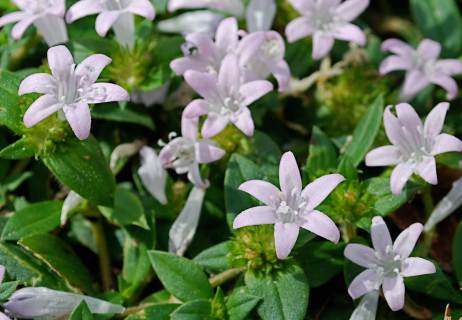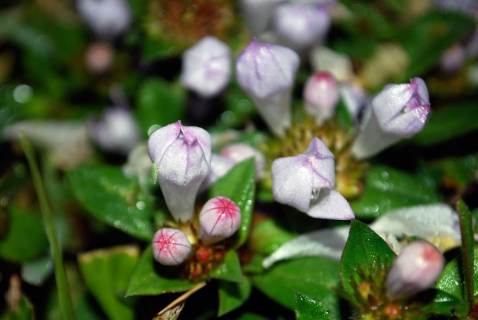A few years ago, back when we still lived in the old neighborhood, I started to see a very pretty pinkish-purplish low-growing flower spreading into certain lawns in my neighborhood. I asked around, but no one seemed to know what it was, although everyone agreed that it was “pretty.” Since I was taking the Florida Master Naturalist classes at the time, I considered it my duty to know what it was, so I asked Steve Bass, my go-to botanist and the man who taught my master naturalist classes, what it might be. He told me that it was a Richardia species, one of several non-native groundcovers that seemed to have become more prominent in the years following our disastrous hurricane seasons of 2004 and 2005. A fairly weedy plant, but pretty, attractive to bees, and not a terrible invasive exotic, either.
Richardia is in the Rubiaceae family, so even though it’s a ground cover, not a shrub, it’s related to some of our favorite native shrubs like Psychotria nervosa (wild coffee), Cephalanthus occidentalis (buttonbush), and even to that showy Hamelia patens (firebush).
I watched its progress through the neighborhood as it showed up in the lawn on the house on the corner. I kept waiting and hoping as it crept from that house (4 doors down from me) to its neighbor, then the next, and finally all the way into my neighbor’s swale. But it never seemed to make it into our yard, and I gave up on it.
Then last spring, we moved a few blocks away, and now my yard is full of it!
Now that I live with a carpet of it, I can testify that it is indeed a Richardia species, R. grandiflora to be precise:
This is the easiest to identify of the four species of Richardia in Florida (R. brasiliensis, R. grandiflora, R. humistrata, and R. scabra), as the flowers are large (at least compared to other species in the genus)—about 3/8-in across. If you don’t feel like measuring flower diameters, you can at least rule out R. humistrata because the flower has 6 petals, not 4, but then separating the other three require you to check whether the fruit is hirsute (brasiliensis) or tuberculate (scabra and grandiflora), and then check the length of the corolla (5-7 mm=scabra, 12-20 mm =grandiflora).
The flowers close at night, as my son and I can attest; seems like every morning when we’re out in the lawn early, I hear the comment that “the flowers are sleeping.”
The bees seem to love it, which is a plus; anything that keeps the bees happy these days seems like a good thing to me:
The genus is named after Richard Richardson who, despite his family name, was the son of a man named William. Richard was an English botanist from the 17th/18th centuries (1663-1741).
References
Hammer, R.L. 2002. Everglades Wildflowers. Guilford, CT: Globe Pequot.
Wunderlin, R.P. & Hansen B.F. (2003). Guide to the Vascular Plants of Florida, 2nd ed. Gainesville: UP of Florida.




I would like to find out where I can buy seeds to plant this beautiful weed in my back yard.